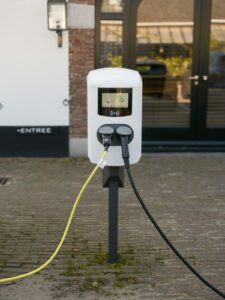
Home / EV Charging News / Are Electric Cars Better for the Environment?
With the increasing popularity of e-mobility technology, many ask themselves: Are electric vehicles actually better for the environment? Internal Combustion Engine (ICE) vehicles produce extremely high levels of pollution, while all-electric cars produce much less pollution and can be considered one of the most important players in the fight against climate change.

Figure 1: EV driving next to a wind farm
In this article, you will learn the most important information about the positive impact of EVs on the environment. Here we analyze why EVs are important for the environment, how they can affect the rapidly accelerating climate change, the lifetime emissions of EVs compared to ICE vehicles, ways to reduce those emissions, and more.
There is no hiding that combustion vehicles are extremely hazardous to the environment. One typical ICE vehicle releases 4.6 metric tons of carbon dioxide (CO2) per year, while the accumulated passenger ICE vehicles generate a total of 3 billion metric tons of CO2 emissions each year, making the transport sector responsible for up to 37% of the worldwide emissions.
Now you might wonder: Are battery powered cars better for the environment and the planet? Well, yes, they are. EVs release zero tailpipe emissions, but they are not entirely free from guilt, since the type of energy used to recharge the battery may release CO2 emissions, like in the case of fossil fuel-generated energy. This is why using the right energy mix to charge your vehicle is important.

Figure 2: Energy Mix in the U.S.
The U.S. energy mix is comprised of 36% petroleum, 32% natural gas, and 11% of coal, but only 8% nuclear energy and 12% renewable energies. If you use energy from the grid to recharge your vehicle, you will likely be powering it with 79% dirty energies. However, even in that case, you will still pollute 43% less than you normally would with ICE vehicles. This is mostly because EVs convert 77% of the energy consumed, while ICE vehicles convert only 12% to 30% of the energy liberated in the combustion process.
Electric cars are good for the environment because they generate much lower CO2 emissions compared to ICE vehicles, and they deliver many other benefits. This is why switching to e-mobility is one of the best things you can do for the environment.
Climate change is the most negative phenomenon caused by Greenhouse Gas (GHG) emissions and pollution. It is expected that climate change will bring dire consequences like extreme temperatures, severe natural disasters, and even health issues & increased levels of poverty. So you may ask: how are electric vehicles better for the environment and what can they do against climate change?

Figure 3: Projected temperatures with future CO2 emissions
At current CO2 emission levels, it is expected that the average temperatures will increase by 7ºF by 2040, and it will worsen in the following years. Coral calcification could grow by 30% and coral growth could be reduced by 50%, meanwhile sea levels can even rise by around 4 feet in the following century.
Lowering GHG emissions will improve air quality and prevent millions of deaths over the century by slowing climate change, but how are electric cars better for the planet and how can they make this happen?
Currently, the transport sector is responsible for 37% of worldwide GHG emissions. Electric vehicles are better for the environment because they pollute 43% less than ICE vehicles and produce 64% fewer emissions during their life-cycle compared to ICE vehicles, which will reduce GHG emissions worldwide. It is even expected that EVs have the potential of reducing GHG emissions in the transport sector to 80% – 90% the current levels.

Figure 4: Emissions released by manufacturing an ICE/EV battery
There are many reasons why electric cars are better for the environment and one of the most powerful tools to reduce GHG emissions and fight climate change, but they are not entirely exempt from polluting. For instance, manufacturing the battery for an EV produces almost twice the amount of pollution compared to manufacturing the battery for an ICE vehicle, but driving an EV pollutes a lot less than driving an ICE vehicle.

Figure 5: Break-even point for emissions for EVs/ICE vehicles
Up to this point, you might be wondering: is producing electric cars better for the environment? The truth is that the life-cycle emissions for EVs and ICE vehicles are estimated to break-even at around 17,400 miles (28,000 km). Keep in mind that on average Americans drive about 14,263 miles per year, according to the Federal Highway Administration.

Figure 6: Pollution for EVs/ICE vehicles at 150,000 km
This means that nearly after a year and a half of using your EV you will have reached the break-even point, point from which your EV carbon footprint will remain at minimum (or almost zero if you use clean energy to charge it) while an ICE vehicle would keep polluting for as long as it is on the road. After driving both vehicles for more than 90,000 miles (150,000 km), the life-cycle emissions will be much lower for the EV, almost 64% lower.

Figure 7: Lithium-Ion Battery Production Model
Reducing the pollution generated at the time EVs are manufactured is one of the most efficient methods to reduce life-cycle emissions for these vehicles. One of the most innovative ways to achieve this is using low-carbon hydrogen or biofuels as the heat energy to process lithium during the manufacturing process of Li-Ion batteries, which could reduce emissions generated by battery manufacturing by as much as 50%.
Some other important considerations and actions can be taken during the production of EVs to reduce GHG Emissions. These are the following:
There is no hiding the effects of climate change in the present day. In the last decades, temperatures have been rising more regularly, natural disasters have occurred with more recurrence and intensity, and other climate change effects have occurred worldwide. To appease the effect of climate change and slow its advance, the best way is to tackle it by reducing GHG emissions.

Figure 8: Green future concept
One of the best ways to reduce GHG emissions is by switching from EVs to ICE vehicles, reducing a considerable portion of the 37% emissions generated by the transport sector. Another action that can be taken is reducing the emissions generated by the energy sector, which accounts for 40% of the global emissions, these can be reduced by switching to renewable energies.
While the results of cutting down emissions will only be seen in a long-term basis, doing the work to stop it from getting worse today is our responsibility as society and as the humankind of the 21st Century to ensure a bright future for next generations.
$2,890.00 Original price was: $2,890.00.$2,790.00Current price is: $2,790.00.
$3,950.00 Original price was: $3,950.00.$3,450.00Current price is: $3,450.00.
$1,650.00 Original price was: $1,650.00.$1,590.00Current price is: $1,590.00.
$2,290.00 Original price was: $2,290.00.$2,150.00Current price is: $2,150.00.
$1,290.00 Original price was: $1,290.00.$799.00Current price is: $799.00.

Your Power Management Partner for Over 25 Years Future Generations Depend on Our Decisions Today ™
2024 © All rights reserved by CyberSwitching